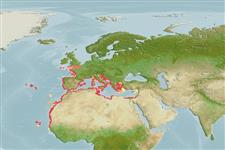>
Eupercaria/misc (Various families in series Eupercaria) >
Moronidae (Temperate basses)
Etymology: Dicentrarchus: Greek, di = two + Greek, kentron = sting + Greek, archos = anus (Ref. 45335).
More on author: Bloch.
Environment: milieu / climate zone / rango de profundidad / distribution range
Ecología
marino; salobre pelagic-neritic; rango de profundidad 30 - ? m (Ref. 5990). Subtropical; 51°N - 10°N
Eastern Atlantic: English Channel (occasional) southward along the coasts of Europe and Morocco to Senegal and the Canary Islands; also southern Mediterranean and the Gulf of Suez.
Length at first maturity / Tamaño / Peso / Age
Madurez: Lm 21.6 range ? - ? cm
Max length : 70.0 cm TL macho / no sexado; (Ref. 57391); common length : 30.0 cm TL macho / no sexado; (Ref. 3397)
Espinas dorsales (total) : 9 - 10; Radios blandos dorsales (total) : 12 - 14; Espinas anales: 3; Radios blandos anales: 10 - 12. Diagnosis: elongate fish with 2 separate dorsal fins and a rather deep caudal peduncle; vomerine teeth patch anchor-shaped, with the posterior teeth extending to the midline of palate; scales on interorbital space ctenoid; opercle with 2 flat spines; lower preopercular margin with large, forward-pointing spines; caudal fin moderately forked; scales small (Ref. 57391).
Coloration: silvery grey, back bluish in life; juveniles and adults with small dark markings scattered over back and sides; a very distinct black spot on opercle (Ref. 57391).
Body shape (shape guide): fusiform / normal.
Coastal species (Ref. 4197), found in coastal marine and brackish waters (Ref. 57391). Occurs on various kinds of bottoms, including sand, muddy sand and rocks; occasionally occurring in rivers (Ref. 6916, 57391). Also capable of living in hypersaline habitats (Sine Saloum in Senegal)(Ref. 57391). Feeds mainly on shrimps and mollusks, also fishes (Ref. 5990).
Life cycle and mating behavior
Madurez | Reproducción | Puesta | Huevos | Fecundidad | Larva
Smith, C.L., 1990. Moronidae. p. 692-694. In J.C. Quero, J.C. Hureau, C. Karrer, A. Post and L. Saldanha (eds.) Check-list of the fishes of the eastern tropical Atlantic (CLOFETA). JNICT, Lisbon; SEI, Paris; and UNESCO, Paris. Vol. 2. (Ref. 6916)
IUCN Red List Status (Ref. 130435: Version 2024-2)
Threat to humans
Harmless
Human uses
Pesquerías: escaso valor comercial; pesca deportiva: si
Herramientas
Special reports
Download XML
Fuentes de Internet
Estimates based on models
Preferred temperature (Referencia
123201): 13.3 - 20.7, mean 17.3 °C (based on 39 cells).
Phylogenetic diversity index (Referencia
82804): PD
50 = 0.7656 [Uniqueness, from 0.5 = low to 2.0 = high].
Bayesian length-weight: a=0.00813 (0.00636 - 0.01039), b=3.03 (2.96 - 3.10), in cm total length, based on LWR estimates for this species (Ref.
93245).
Nivel trófico (Referencia
69278): 3.9 ±0.65 se; based on food items.
Resiliencia (Referencia
120179): Medio, población duplicada en un tiempo mínimo de 1.4-4.4 años (K=0.07-0.16).
Prior r = 0.25, 95% CL = 0.16 - 0.37, Based on 1 full stock assessment.
Fishing Vulnerability (Ref.
59153): Moderate vulnerability (36 of 100).
🛈
Climate Vulnerability (Ref.
125649): High to very high vulnerability (74 of 100).
🛈
Nutrients (Ref.
124155): Calcium = 35.4 [3.9, 188.9] mg/100g; Iron = 0.815 [0.282, 2.003] mg/100g; Protein = 20.5 [19.2, 21.9] %; Omega3 = 0.345 [0.187, 0.624] g/100g; Selenium = 10.5 [3.3, 29.4] μg/100g; VitaminA = 9.83 [2.35, 42.99] μg/100g; Zinc = 0.716 [0.328, 1.624] mg/100g (wet weight); based on
nutrient studies.
